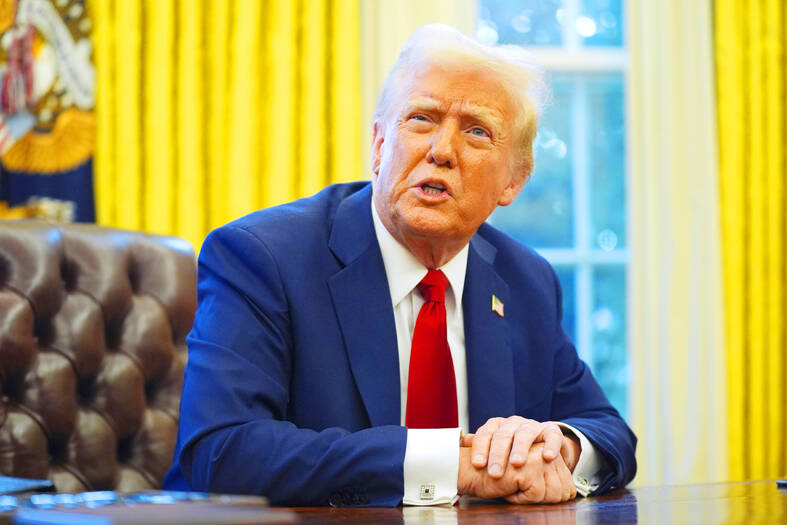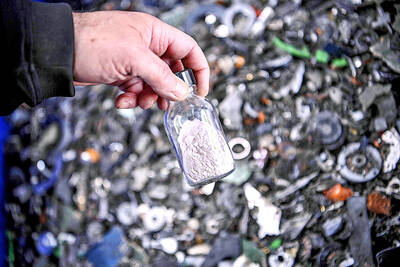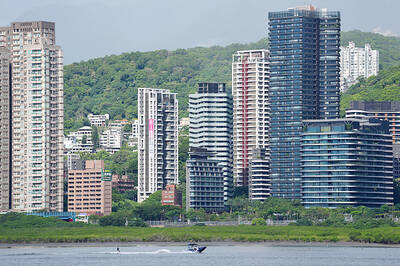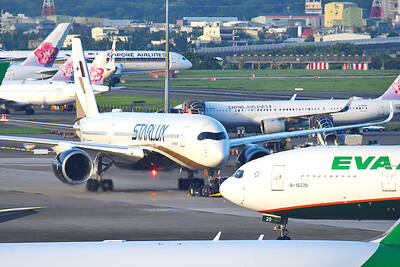US President Donald Trump said his 25 percent tariffs on Canada and Mexico are coming today, but he is still considering whether to include oil from those countries as part of his import taxes.
“We may or may not,” Trump told reporters on Thursday in the Oval Office about tariffing oil from Canada and Mexico. “We’re going to make that determination probably tonight.”
Trump said his decision would be based on whether the price of oil charged by the two trading partners is fair, although the basis of his threatened tariffs pertains to stopping illegal immigration and the smuggling of chemicals used for fentanyl.

Photo: AP
The risk of tariffs on Canadian and Mexican oil could undermine Trump’s repeated pledge to lower overall inflation by reducing energy costs.
Costs associated with tariffs could be passed along to consumers in the form of higher gasoline prices — an issue that Trump placed at the center of his Republican presidential campaign as he vowed to halve energy costs within one year.
The US imported almost 4.6 million barrels of oil daily from Canada in October last year and 563,000 barrels from Mexico, according to the US Energy Information Administration.
US daily production during that month averaged nearly 13.5 million barrels a day.
Matthew Holmes, executive vice president and chief of public policy at the Canadian Chamber of Commerce, said Trump’s tariffs would “tax America first” in the form of higher costs.
“This is a lose-lose,” Holmes said.
“We will keep working with partners to show President Trump and Americans that this doesn’t make life any more affordable. It makes life more expensive and sends our integrated businesses scrambling,” Holmes added.
Trump also said that China would pay tariffs for its exporting of the chemicals used to make fentanyl. He has previously stated a 10 percent tariff that would be on top of other import taxes charged on products from China.
Global crude oil prices were trading at roughly US$73 a barrel on Thursday afternoon. Gasoline prices were averaging US$3.12 a gallon across the US, roughly the same price as a year ago, according to AAA.
Later on Thursday, Trump threatened more tariffs against countries looking at alternatives to the US dollar as a means of global exchange.
The president made the same threat in November last year against the so-called BRICS group, which includes Brazil, Russia, India, China, South Africa, Egypt, Ethiopia, Iran and the United Arab Emirates.
Russian President Vladimir Putin has suggested that sanctions against his country and others mean that nations need to develop a substitute for the US dollar.
“We are going to require a commitment from these seemingly hostile Countries that they will neither create a new BRICS Currency, nor back any other Currency to replace the mighty US Dollar or, they will face 100 percent Tariffs, and should expect to say goodbye to selling into the wonderful US Economy,” Trump posted on social media.

RECYCLE: Taiwan would aid manufacturers in refining rare earths from discarded appliances, which would fit the nation’s circular economy goals, minister Kung said Taiwan would work with the US and Japan on a proposed cooperation initiative in response to Beijing’s newly announced rare earth export curbs, Minister of Economic Affairs Kung Ming-hsin (龔明鑫) said yesterday. China last week announced new restrictions requiring companies to obtain export licenses if their products contain more than 0.1 percent of Chinese-origin rare earths by value. US Secretary of the Treasury Scott Bessent on Wednesday responded by saying that Beijing was “unreliable” in its rare earths exports, adding that the US would “neither be commanded, nor controlled” by China, several media outlets reported. Japanese Minister of Finance Katsunobu Kato yesterday also

Taiwan’s rapidly aging population is fueling a sharp increase in homes occupied solely by elderly people, a trend that is reshaping the nation’s housing market and social fabric, real-estate brokers said yesterday. About 850,000 residences were occupied by elderly people in the first quarter, including 655,000 that housed only one resident, the Ministry of the Interior said. The figures have nearly doubled from a decade earlier, Great Home Realty Co (大家房屋) said, as people aged 65 and older now make up 20.8 percent of the population. “The so-called silver tsunami represents more than just a demographic shift — it could fundamentally redefine the

China Airlines Ltd (CAL, 中華航空) said it expects peak season effects in the fourth quarter to continue to boost demand for passenger flights and cargo services, after reporting its second-highest-ever September sales on Monday. The carrier said it posted NT$15.88 billion (US$517 million) in consolidated sales last month, trailing only September last year’s NT$16.01 billion. Last month, CAL generated NT$8.77 billion from its passenger flights and NT$5.37 billion from cargo services, it said. In the first nine months of this year, the carrier posted NT$154.93 billion in cumulative sales, up 2.62 percent from a year earlier, marking the second-highest level for the January-September

Businesses across the global semiconductor supply chain are bracing themselves for disruptions from an escalating trade war, after China imposed curbs on rare earth mineral exports and the US responded with additional tariffs and restrictions on software sales to the Asian nation. China’s restrictions, the most targeted move yet to limit supplies of rare earth materials, represent the first major attempt by Beijing to exercise long-arm jurisdiction over foreign companies to target the semiconductor industry, threatening to stall the chips powering the artificial intelligence (AI) boom. They prompted US President Donald Trump on Friday to announce that he would impose an additional